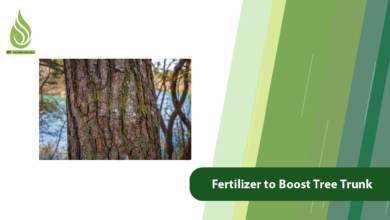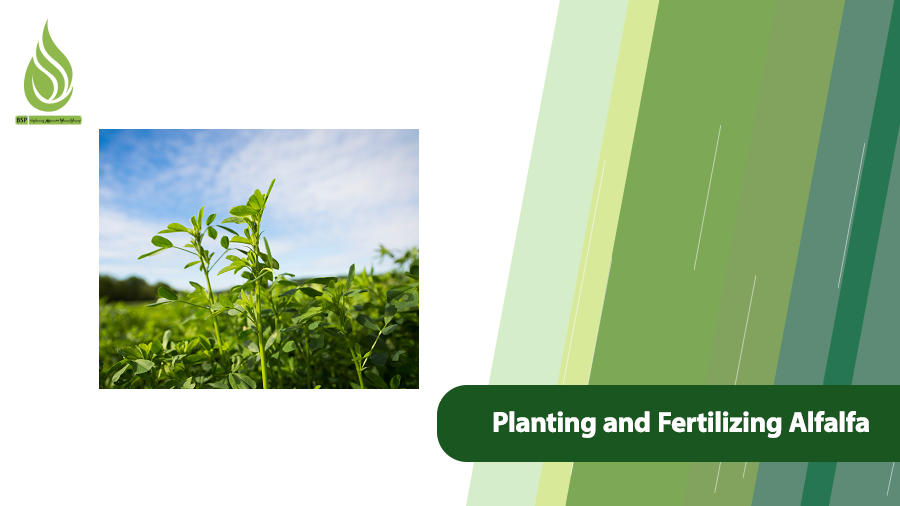
Comprehensive Guide to Planting and Fertilizing Alfalfa
Alfalfa, often hailed as the “Queen of Forages,” is one of the most vital perennial forage crops worldwide. With its exceptional nutritional profile, adaptability to diverse climates, and ability to enhance soil health through nitrogen fixation, it has become a cornerstone for farmers, ranchers, and livestock producers. Beyond its role as a premium livestock feed, planting alfalfa improves soil fertility by partnering with Rhizobium bacteria to convert atmospheric nitrogen into plant-usable forms, reducing the need for synthetic fertilizers and promoting sustainable farming practices.
This guide delves into the essentials of planting alfalfa, from botanical basics to advanced fertilization techniques, drawing on proven strategies to boost yields and ensure long-term stand health. We’ll also incorporate insights from reliable agricultural resources, such as university extension services and agronomy guides, to offer a thorough, practical roadmap for success. Whether you’re a novice grower or an experienced farmer, these tips can help you achieve harvests of 4 to 8 tons per acre or more, depending on your region and management.
Alfalfa Botany and Planting
Alfalfa (Medicago sativa) is a deep-rooted, perennial legume that thrives for 3 to 7 years—or even longer under ideal conditions—making it a reliable choice for multi-year forage production. Its robust structure supports multiple harvests annually, setting it apart from annual crops.
- Roots: Alfalfa’s root system is one of its standout features, extending up to 20 feet deep in well-drained soils. These roots not only anchor the plant but also host symbiotic Rhizobium bacteria in nodules, enabling the fixation of up to 200 pounds of nitrogen per acre annually. This natural process balances the soil’s carbon-to-nitrogen ratio, enriching the earth for subsequent crops like corn or wheat in rotation systems.
- Stems: The plant produces numerous branched stems, typically reaching 12 to 32 inches (30 to 80 cm) in height, though they can stretch to 48 inches (120 cm) in favorable environments. Stems are key to yield, as they support leaves and flowers while contributing to the plant’s regrowth after cutting.
- Leaves: Compound and trifoliate, alfalfa leaves consist of three oval-shaped leaflets with fine serrations along the edges. These leaves are the primary site of photosynthesis and contain the bulk of the plant’s nutritional value, including proteins and vitamins.
- Flowers: Small, butterfly-like blooms appear in clusters, usually in shades of purple or blue, though varieties may vary. Pollination by bees is crucial for seed production, and flowering signals peak nutritional quality for harvest.
- Seeds: Yellow to light brown, alfalfa seeds are small and kidney-shaped, with high germination rates when properly stored and inoculated.
Variety selection is critical here. Modern alfalfa cultivars are rated for fall dormancy (how much growth occurs after September) and winter hardiness (on a 1-6 scale, with 1 being the most hardy). For instance, less dormant varieties (fall dormancy rating 6-10) yield more in mild climates but may suffer in harsh winters, while hardy ones (rating 1-3) suit northern regions. Choosing certified, disease-resistant seeds ensures resilience against common threats like bacterial wilt or root rot.
Characteristics of Alfalfa
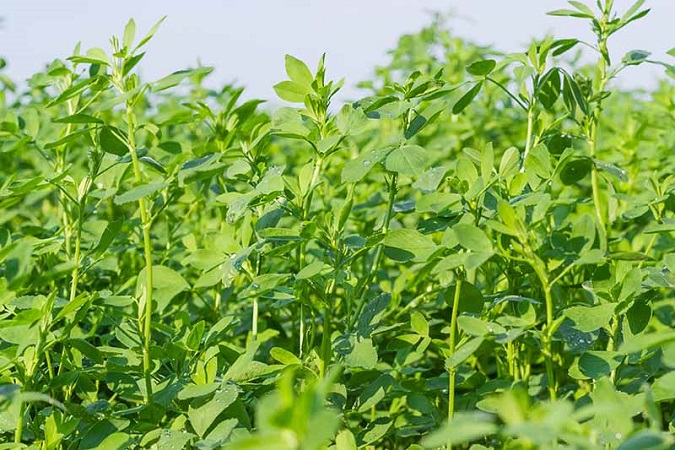
As a cool-season perennial, alfalfa exhibits remarkable adaptability:
- Lifespan: Typically 3-7 years, with stands persisting longer in well-managed fields through proper nutrition and pest control.
- Light Needs: Full sunlight is essential; alfalfa is shade-intolerant, requiring at least 6-8 hours of direct sun daily for optimal photosynthesis and growth.
- Water Requirements: Moderate to high, with deep roots providing drought tolerance once established. However, consistent moisture is key during establishment and regrowth, using about 4-6 inches of water per ton of dry matter produced.
- Temperature Range: Ideal growth occurs between 64°F and 86°F (18-30°C), though it withstands freezes down to -20°F in dormant states. Extreme heat above 95°F can induce wilting and reduce yields.
Alfalfa’s growth stages include germination (5-10 days at optimal soil temperatures of 68-82°F), seedling development, vegetative growth, budding, flowering, and seed set. During vegetative phases, the plant builds energy reserves in roots for winter survival and spring regrowth.
Agricultural and Forage Significance
Alfalfa’s nutritional powerhouse status stems from its 18-22% crude protein content, along with abundant calcium (1.2-1.5%), phosphorus (0.2-0.3%), and vitamins like A, E, and K. This makes it superior to many grasses for animal health, supporting milk production in dairy herds and weight gain in beef cattle.
- Harvest Potential: In irrigated systems, expect 3-8 cuts per year, yielding 4-10 tons per acre depending on climate and management. For example, in California’s Central Valley, yields can exceed 8 tons with proper irrigation.
- Soil Benefits: By fixing 100-300 pounds of nitrogen per acre, planting alfalfa enhances soil fertility, reduces erosion, and supports biodiversity. Rotating with grains can cut fertilizer costs by 50% in the following crops.
- Utilization Forms: Fresh grazing, silage for wet storage, or hay for dry feeding. Hay quality is graded by Relative Feed Value (RFV), with premium alfalfa (RFV >150) fetching higher prices for horses and dairy.
Optimal Soil Conditions for Planting Alfalfa
Success starts with the right soil:
- Type: Loamy-sandy or loamy-silty soils with excellent drainage are ideal to prevent waterlogging, which fosters diseases like Phytophthora root rot. Avoid heavy clays or flood-prone areas; organic matter above 2% aids moisture retention and root penetration.
- pH Level: Aim for 6.5-7.5 to maximize nutrient uptake and bacterial activity. Below 6.0, aluminum toxicity hinders roots; above 8.0, micronutrient deficiencies arise. Apply lime (1-3 tons/acre of calcium carbonate equivalent) 6-12 months pre-planting if needed, based on soil tests.
- Depth: Minimum 3 feet (90 cm) for deep rooting; deeper soils (5-6 feet) enhance drought resistance and yield stability. Compacted layers should be subsoiled to 18-24 inches.
- Slope: Less than 2% to minimize erosion; on steeper ground, use contour planting or cover crops.
Conduct soil tests every 1-2 years to monitor nutrients, targeting 30-50 ppm phosphorus and 150-250 ppm potassium for established stands.
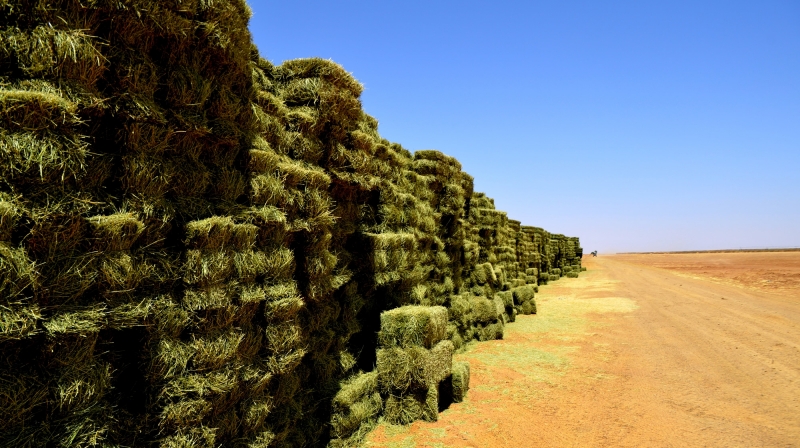
Climatic Requirements for Successful Cultivation
Alfalfa excels in temperate to semi-arid climates:
- Temperature: Thrives in mild weather; cold-hardy varieties survive winters in zones 3-9. Avoid planting if soil temperatures dip below 50°F or exceed 90°F, as this slows germination.
- Sunlight: At least 6 hours daily; shaded areas reduce yields by 20-30%.
- Precipitation/Irrigation: 15-25 inches annually, supplemented by irrigation in dry regions. Peak water use is 0.3-0.5 inches/day in summer.
Nutritional Demands and Fertilization Strategies
Alfalfa’s frequent harvests deplete soils rapidly, removing 50-60 pounds of nitrogen, 10-15 pounds phosphorus, and 50-60 pounds potassium per ton of hay. A tailored program is essential:
- Phosphorus (P): Vital for root development and energy transfer; apply 60-120 lbs/acre (P2O5 equivalent) based on tests. Deficiency shows as stunted growth and purple leaves.
- Nitrogen (N): Minimal needs post-establishment due to fixation; add 30-50 lbs/acre in year one or on sandy soils. We suggest you take a look at our guide to nitrogen and microorganisms.
- Potassium (K): Enhances stress resistance; 80-150 lbs/acre (K2O) annually, split post-harvest to avoid salt burn.
- Sulfur (S): 20-50 lbs/acre for protein synthesis, especially in low-organic soils.
- Calcium (Ca): Supplied via lime; deficiencies rare in neutral pH.
- Micronutrients: Boron (1-3 lbs/acre) prevents hollow stems; molybdenum aids fixation; zinc and manganese for enzyme function.
General Program:
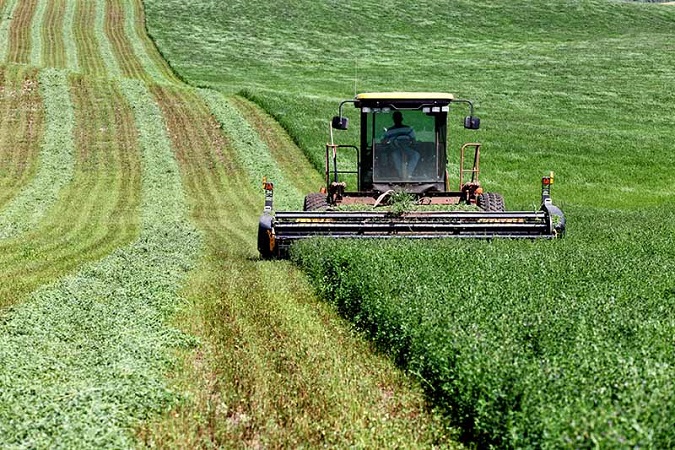
- Pre-Plant: Incorporate P, K, N, and lime.
- Post-Cut: Topdress P and K to replenish.
- Periodic: Test soils every 2-3 years; foliar sprays for micros if deficient.
In organic systems, use compost or rock phosphate, ensuring Rhizobium inoculation for N.
Practical Tips for Planting and Managing Alfalfa
- Timing: Spring (post-frost) or late summer (6-8 weeks pre-frost). In cooler areas, early spring; warmer zones, fall for root establishment. We suggest you take a look at our guide to fall planting crops.
- Depth and Spacing: Seed 0.25-0.5 inches deep at 12-20 lbs/acre; rows 6-12 inches apart for drills, or broadcast with cultipacker.
- Seed Selection: Opt for certified, inoculated seeds with 85%+ germination; resistant to local pests.
- Irrigation: Water every 5-7 days initially (1 inch/week); adjust to evapotranspiration rates.
- Pest/Disease Control: Monitor for alfalfa weevil (treat at 1-2 larvae/stem), aphids, and fungi. Use IPM: resistant varieties, scouts, and targeted sprays. Natural predators like ladybugs help.
- Harvest: Cut at 10% bloom for balance of yield and quality; 28-35 day intervals. Use mowers with conditioners; dry to 15-20% moisture for storage to avoid mold.
Prepare fields by tilling to a firm seedbed, controlling weeds pre-plant with herbicides if needed.
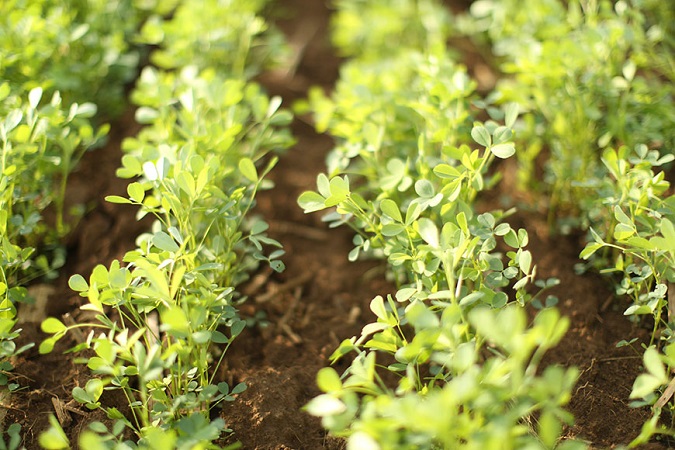
Conclusion
Planting alfalfa offers unparalleled opportunities for sustainable forage production, soil enrichment, and economic gains. By fixing nitrogen, it reduces fertilizer inputs and boosts microbial activity, cutting pesticide needs and supporting eco-friendly farming. With diligent attention to seed choice, irrigation, nutrition, and pest management—backed by soil tests and regional adaptations—growers can sustain productive stands yielding high-quality hay or graze. In rotations, alfalfa leaves behind fertile soil, benefiting entire farm systems. Embrace these practices, and alfalfa can transform your operation into a model of efficiency and profitability.
